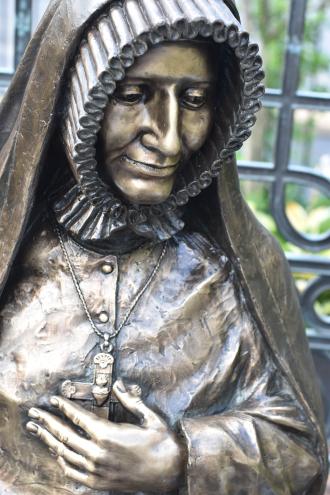
Two hundred years ago, on August 21, 1818, Mother Rose Philippine Duchesne (now a saint) and four companions from France arrived in St. Louis aboard the steamboat Franklin after a hot, 40-day journey up the Mississippi River from New Orleans. For their first three weeks in St. Louis, the five Religious of the Sacred Heart slept in a house on what is now the grassy area under the Gateway Arch. They were guests in a two-story French colonial house on Market and Main streets owned by General Bernard and Emilie Labadie Pratte. (Emilie Pratte was the granddaughter of City of St. Louis founder Pierre Laclede and Marie Therese Chouteau.) General Bernard Pratte, along with Jean-Pierre Chouteau, were major agents of the booming fur trade that came down the Missouri River and, although Philippine did not write about it, it is probable that in the summer of 1818, while staying at the Pratte house, she met William Clark of the famous Lewis and Clark Expedition. Philippine also attended Mass in the Church of St. Louis, the King, located at the site of today’s Old Cathedral. In 1818, it was the second church on this site. In 1834, she donated money for the building of the first cathedral, or third church, on this site. The cathedral located there now is the fourth church on this site. The cathedral grounds are the only land in St. Louis that has had the same owner for 254 years (as of 2018). Philippine was invited to St. Louis by Bishop William DuBourg, who promised them a site for a school, but he had not made arrangements for one. The Prattes worked to find rental property for a school but without success. At that time, St. Louis was a boom town, and Philippine wrote that rents were higher than those in Paris. After three weeks, DuBourg accompanied the five sisters 24 miles west, across the Missouri River, to the frontier village of St. Charles. They arrived on September 7, 1818, and on September 14, 1818, they opened the Academy of the Sacred Heart, the first free school west of the Mississippi River. Today it is a thriving private grade school. The students, faculty and staff treasure their Philippine heritage. Philippine also opened other schools in St. Louis and Louisiana. In 1841, Philippine’s desire to serve among the native people came to fruition. At the specific request of Fr. Peter Verhaegen, the Jesuit in charge of the mission, she went with three other Religious of the Sacred Heart to Sugar Creek, Kansas, to establish a school for Potawatomi girls. At 72, she was too frail to be of much help with the physical work, and she could not learn the Potawatomi language. She spent much of her time in prayer, gaining the name “Woman Who Prays Always.” After just one year, she was called back to St. Charles because of her health. Although she was in Sugar Creek just a short time, she made a deep impression on the Potawatomi. Mother Rose Philippine Duchesne died November 18, 1852, in St. Charles, where her sarcophagus is located today. She was canonized by Pope John Paul II on July 3, 1988. There are two shrines to Saint Philippine in the St. Louis metropolitan area: the Academy of the Sacred Heart, 619 N. 2nd St. in St. Charles, and Old St. Ferdinand, 1 Rue St. Francois in Florissant. A new sculpture of Saint Philippine was recently installed at the Cathedral Basilica of St. Louis, 4431 Lindell Blvd.
